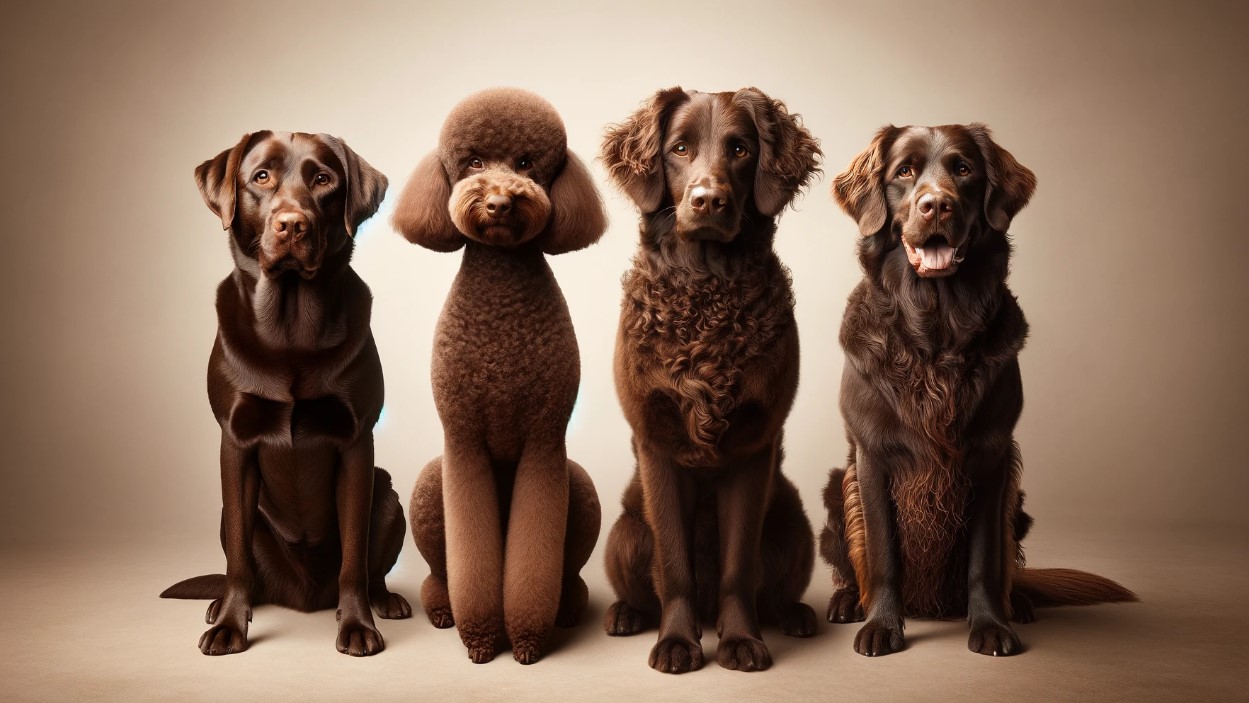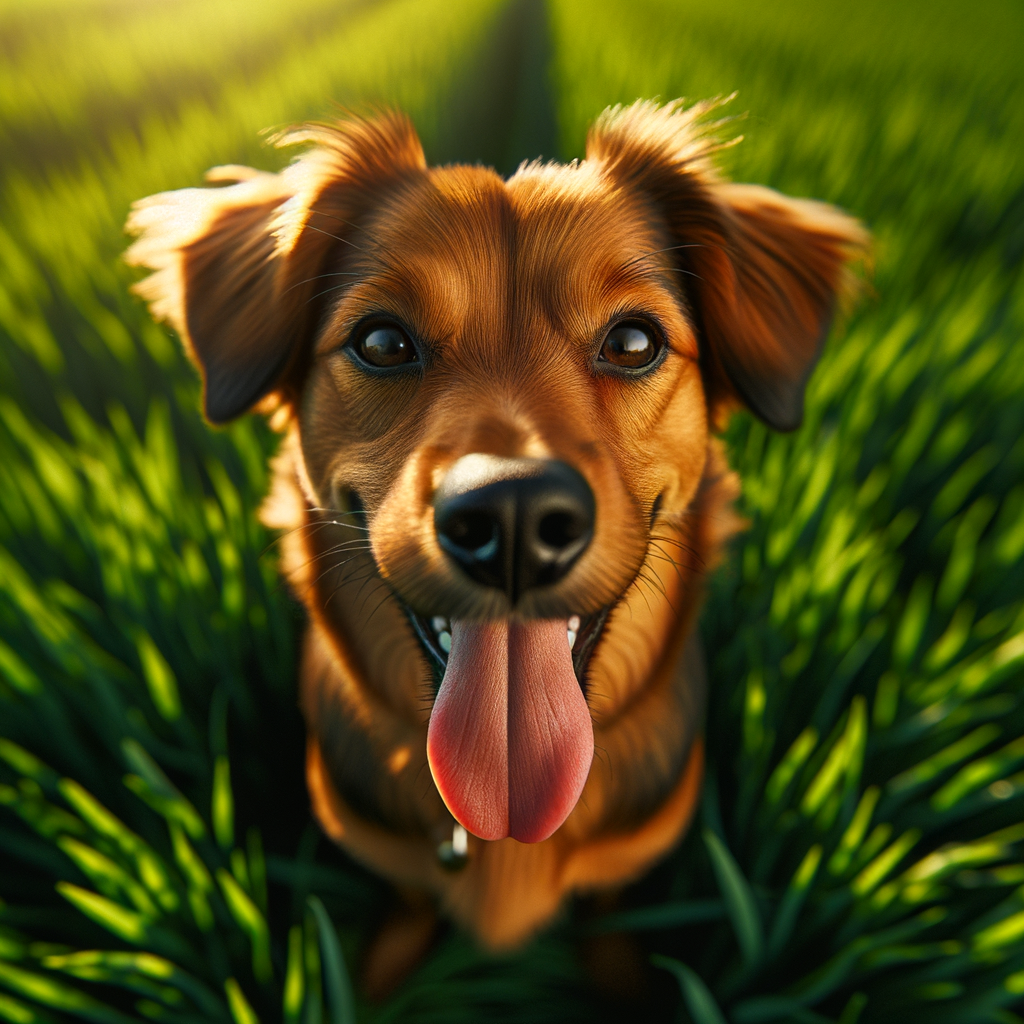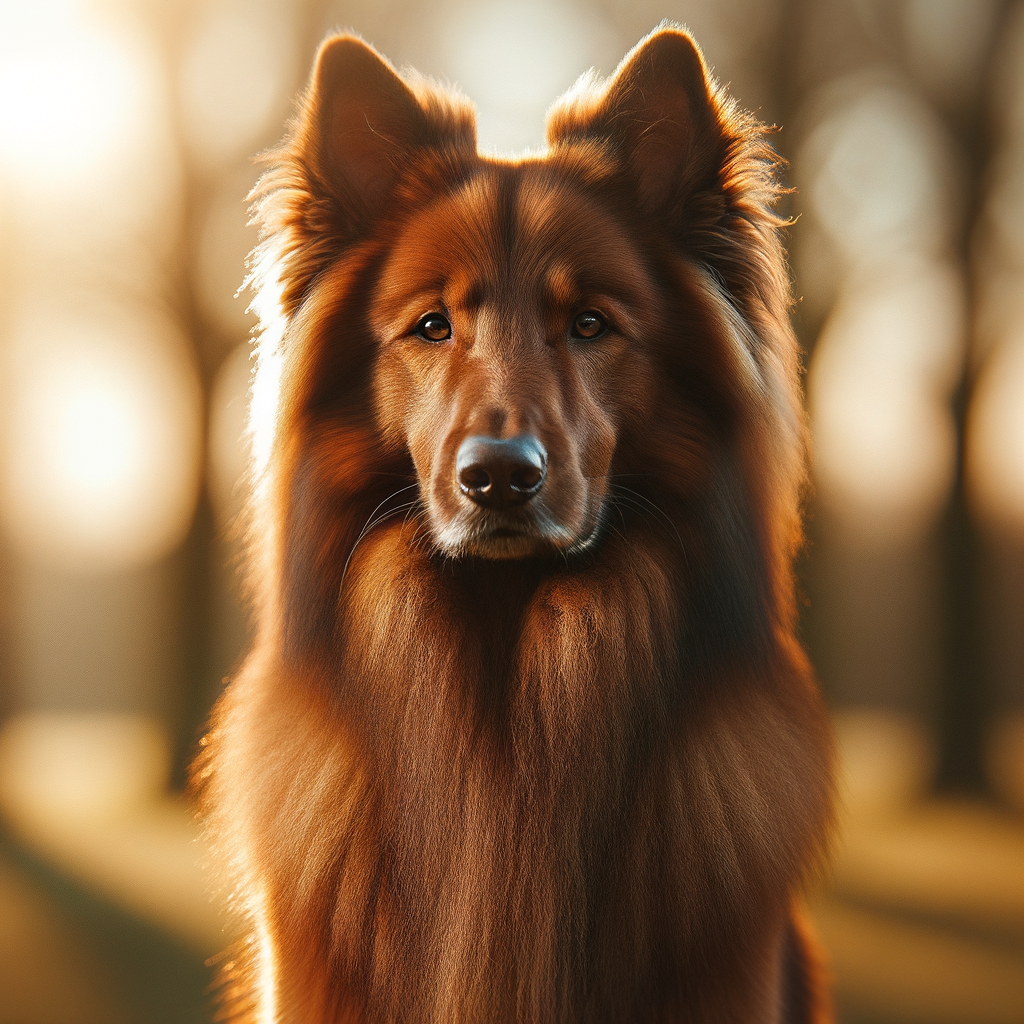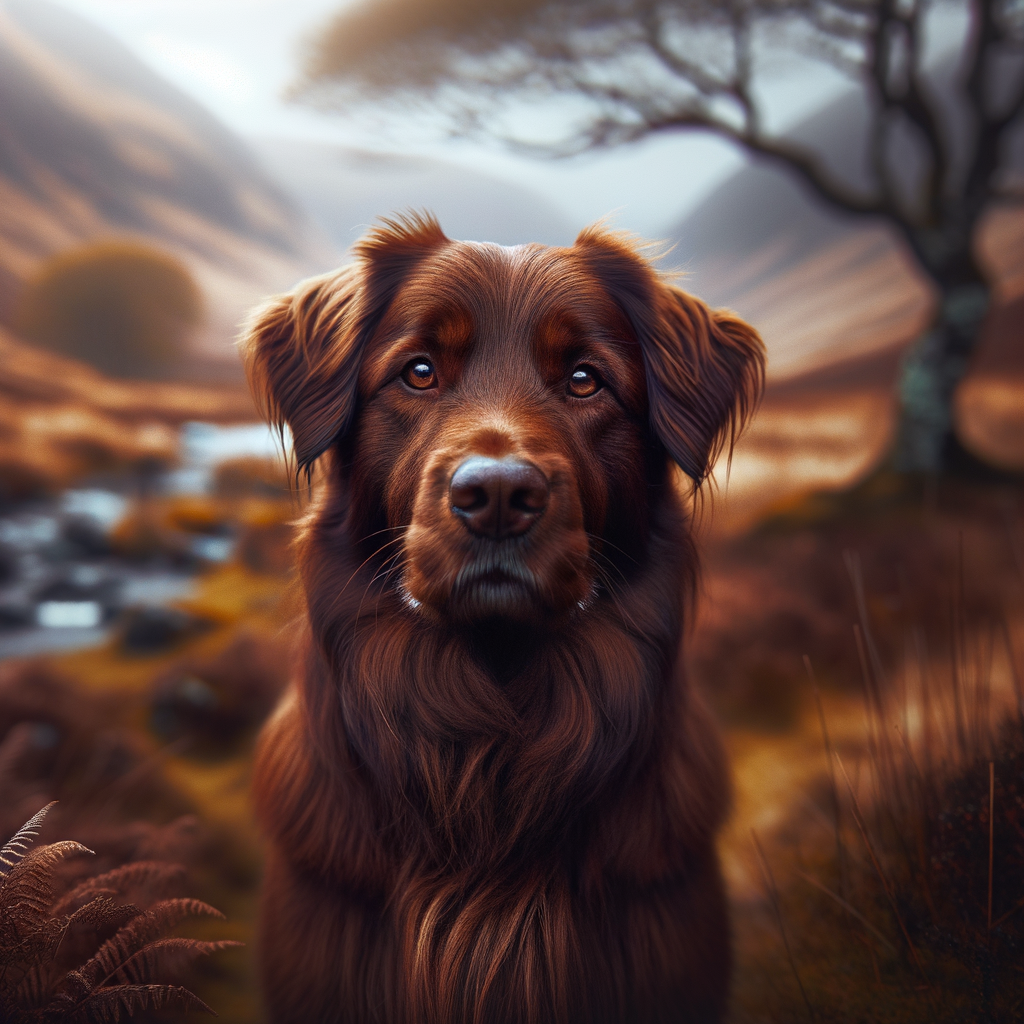If you’re a dog lover, you’ve probably noticed the breathtaking variety of coat colors in our furry friends. Among those, brown dog breeds — often affectionately referred to as “chocolate” canines — seem to hold a special appeal. Whether it’s the rich, deep hues or the sense of warmth these dogs exude, there’s no denying the allure of these cocoa-colored companions.

Understanding the Appeal of Brown Dog Breeds
When it comes to dogs, brown is a color that invariably turns heads. Perhaps it’s because these dog breeds appear warm, friendly, and approachable. Or maybe it’s the impressive range of shades, from light, creamy brown to deep, luxurious chocolate. Regardless, these brown beauties have a charm that’s hard to resist.
The Variety of Chocolate-Colored Canines
The world of brown dog breeds is wonderfully diverse. From the bouncy Labrador Retriever and the chic Chocolate Poodle to affectionate little brown lap dogs, there’s a chocolate-colored canine for virtually every lifestyle and preference. Some are born with their brown coats, while others develop them as they mature. Some breeds are entirely brown, while others sport a mix of brown and other colors. But no matter the shade or pattern, one thing’s for certain: these dogs are undeniably attractive.
So, what makes these dogs so captivating? Is it simply a matter of aesthetics, or is there more to the story? In the following sections, we’ll delve into the fascinating world of brown dog breeds, exploring everything from the genetics behind their beautiful coats to their health, care, and behavior. We’ll even introduce you to some popular breeds and offer advice on adopting your own chocolate-colored canine. So, if you’re intrigued by the charm of brown dog breeds, read on to discover more about these delightful dogs.
Ever wondered why your adorable chocolate-colored canine companion boasts that beautiful brown coat? The answer lies deep within their genes. Understanding the genetics behind brown dog breeds is like unlocking a fascinating puzzle that has everything to do with nature’s coloring box. Let’s dive in!
The Role of Genes in Determining Dog Coat Color
Just like hair color in humans, the color of a dog’s coat is determined by their genetic makeup. Specifically, two types of pigment contribute to a dog’s coat color: eumelanin and pheomelanin. Eumelanin is responsible for the black, brown, and blue shades, while pheomelanin creates red, yellow, and cream coats.
Now, let’s focus on our brown darlings. The brown or chocolate color in dogs is a result of eumelanin pigment, which usually produces a black color. However, when the eumelanin pigment is ‘diluted’, it manifests as brown or chocolate. This ‘dilution’ is the result of a specific gene variant that suppresses the full expression of eumelanin. So if you have a lovely brown dog, you can thank the gene variant for this unique coloration!
Why Some Breeds are Predominantly Brown
So, why do we see some dog breeds predominantly in brown shades? Well, the answer takes us back to the roots of selective dog breeding. For centuries, humans have been selectively breeding dogs based on certain desirable traits, and color was one of these. Certain dog breeds were selectively bred to maintain their brown coats. For instance, the Labrador Retriever, a breed known for its chocolate variety, was selectively bred to maintain this appealing color.
In some breeds, their brown coloring also served a functional purpose. Certain breeds like the Chesapeake Bay Retriever were preferred in brown shades as their coat color provided camouflage while retrieving games in different landscapes. Thus, the prevalence of brown color in certain dog breeds is a combination of both natural genetics and selective breeding by humans.
There are also a few breeds where brown is a dominant color, meaning that even if only one parent is brown, there’s a high chance the puppies will also be brown. This is especially true for breeds like the Irish Setter and the Chocolate Labrador.
So there you have it, a peek into the fascinating world of doggy genetics and why our furry friends sport such beautiful brown coats. Remember, the color of your dog’s coat doesn’t define their personality or health – it’s just one of the many things that makes them special.
Whether your canine companion is a rich dark chocolate, a light cinnamon brown, or any shade in between, you can now appreciate not just their beauty but the genetic marvel behind their coat. So next time you look into those endearing eyes of your brown fur friend, you’ll know a little more about the color that makes them stand out in the doggy crowd.

Health and Wellness of Brown Dog Breeds
When it comes to brown dog breeds, their health and wellness is a priority for any dog parent. Chocolate-colored canines are not just appealing to the eye, but they also bring a whole lot of love and joy into our lives. Therefore, it’s important to understand the health issues that they might face and learn how to maintain their health effectively.
Common Health Issues in Brown Dog Breeds
Just like humans, dogs can also be prone to certain health issues based on their genetics. Here are a few common health problems that can affect brown dog breeds:
– Chocolate Labradors: They are prone to obesity, ear infections, and joint issues like hip and elbow dysplasia.
– Chocolate Poodles: They may face issues such as progressive retinal atrophy, hip dysplasia, and epilepsy.
– Chesapeake Bay Retrievers: This breed can be susceptible to hip and elbow dysplasia, progressive retinal atrophy, and hypothyroidism.
Remember, these are just probabilities and it doesn’t mean that your brown-coated fur baby will definitely suffer from these issues. Regular check-ups with the vet can help catch any potential health problems early.
How to Maintain the Health of Chocolate-Colored Canines
Maintaining the health of your chocolate-colored canine involves a balanced diet, regular exercise, mental stimulation, and preventive healthcare. Here are some tips:
– Diet: Ensure your dog is getting a balanced diet with the essential nutrients. Avoid overfeeding as obesity can lead to several health issues.
– Exercise: Regular exercise is vital for the overall health and happiness of your dog. Whether it’s a walk in the park, a game of fetch, or a swim in the lake, make sure your brown dog gets plenty of physical activity.
– Mental Stimulation: Mental exercises are just as important as physical ones. Toys, puzzles, and training sessions can keep their mind sharp.
– Preventive Healthcare: Regular vet check-ups, vaccinations, and preventive treatments for fleas, ticks, and worms are all part of maintaining the health of your dog.
– Grooming: Regular grooming is not just about keeping your dog looking good. It also prevents skin issues and is a good opportunity to check for any unusual lumps, bumps, or skin abnormalities.
Adopting a brown dog breed means you’re welcoming a delightful bundle of joy into your life. Knowing about their potential health issues and how to maintain their health will ensure that you and your chocolate-colored canine can enjoy a long, happy life together. Remember, every dog is unique, and what works for one might not work for another. Always consult your vet for the best advice for your individual pet’s needs.
Popular Brown Dog Breeds
When it comes to brown dog breeds, the variety is as rich as the color itself. Let’s take a closer look at two of the most popular breeds that come in this delightful hue.
Labrador Retriever: The Most Popular Brown Breed
The Labrador Retriever, often known as the “Lab,” is one of the most adored brown dog breeds worldwide. Labs are renowned for their friendly and outgoing personality, making them excellent family pets. They are also known for their agility and their love for water, thanks to their webbed paws and otter-like tail.
Labs come in three main colors: black, yellow, and chocolate or brown. The chocolate Lab, with its deep brown coat, is especially breathtaking. These dogs have a strong, muscular body and a dense, weather-resistant coat. Their expressive eyes, in shades of brown or hazel, are often described as the windows to their affectionate, eager-to-please nature.
Their high energy levels and intelligent nature make them ideal for various roles, including guide dogs, service dogs, and search and rescue dogs. However, they are also quite content to be a loving companion in a home setting, especially if they get plenty of exercises and mental stimulation.
Chocolate Poodle: A Unique Brown Dog Breed
Poodles, famous for their curly and hypoallergenic coat, come in several colors, including a lovely shade of brown often referred to as “chocolate” or “café au lait.” The brown Poodle, regardless of whether it’s a Standard, Miniature, or Toy, exudes elegance and intelligence, two characteristics that Poodles are known for.
- Appearance: Chocolate Poodles have a unique, dense curly coat that ranges from light brown to deep, dark chocolate. Their eyes and nose are usually dark brown, giving them a harmonious look.
- Temperament: Poodles are exceptionally smart and trainable, often winning top honors at various dog shows and competitions. Despite their aristocratic looks, they are playful and adventurous, making them a joy to be around.
- Health: Poodles are generally a healthy breed. However, like all breeds, they are prone to certain genetic health conditions. Regular check-ups and a balanced diet can help ensure a long and healthy life.
In conclusion, if you’re interested in brown dog breeds, the Labrador Retriever and the Poodle are both excellent choices. Both breeds are known for their intelligence, friendly nature, and adaptability, making them wonderful companions for any dog lover. With proper care, love, and attention, these chocolate-colored canines can bring joy, happiness, and a touch of elegance to your everyday life.

Detailed Profiles of Brown Dog Breeds
When considering brown dog breeds, it’s essential to understand that each breed has unique characteristics and temperaments. Let’s delve into the world of chocolate-colored canines and explore what makes each breed special.
Breed Characteristics and Temperament
Each brown dog breed has a set of unique characteristics and temperaments. Let’s look at some popular brown dog breeds and their respective traits.
- Labrador Retriever: Known for their friendly and outgoing nature, Labradors are excellent family pets. They are intelligent, easy to train, and have a high energy level, making them great companions for active individuals or families.
- Chocolate Poodle: Poodles, regardless of their color, are known for their intelligence and elegance. They are highly trainable and excel in obedience training. Despite their sophisticated appearance, they are quite playful and love to be the center of attention.
- Chesapeake Bay Retriever: This breed is known for its love of water and excellent retrieving skills. They are intelligent, courageous, and make great watchdogs. They are also known for their loyalty and protective nature towards their families.
Remember, these are general breed characteristics. Individual dogs may vary in temperament and behavior based on their upbringing and socialization.
Ideal Living Conditions for Each Breed
Just as each breed has its unique personality traits, they also have specific needs when it comes to their living conditions.
- Labrador Retriever: Labradors are active dogs that require plenty of exercise. They thrive in homes with large yards where they can run and play. However, they can adapt to apartment living as long as they get enough physical activity and mental stimulation.
- Chocolate Poodle: Poodles are adaptable and can do well in various living situations. They are generally good with other pets and children. They do need mental stimulation and physical exercise, so a home where they can play and be active is ideal.
- Chesapeake Bay Retriever: This breed needs a lot of exercise and would do best in a home with a large yard. They are also known to be quite independent and may prefer a quieter household with fewer pets or children.
Before choosing a brown dog breed, consider your living situation and lifestyle. Make sure you can provide the right environment for your new furry friend to thrive.
Training Techniques for Chocolate-Colored Canines
Training a brown dog breed, just like any other dog, requires consistency, patience, and a lot of positive reinforcement. However, these chocolate-colored canines may have specific traits that you need to factor in during training sessions.
Understand their Energy Levels
Some brown dog breeds like the Labrador Retriever are known for their high energy levels. Such dogs require plenty of exercises to keep them mentally and physically stimulated. Incorporate fetch games and long walks into the training routine for these active breeds.
Clicker Training
Clicker training can be effective for brown dog breeds, especially for those that are food-motivated like the Chocolate Poodle. The clicker sound serves as a marker for the desired behavior and is always followed by a treat, creating a positive association.
Mental Stimulation
Breeds like the Chesapeake Bay Retriever are not just physically active, but also incredibly intelligent. These dogs thrive on mental stimulation, so puzzle toys and trick training should be part of the routine.
Understanding the Behavior of Brown Dog Breeds
Understanding your dog’s behavior is crucial in providing appropriate training methods. Recognizing the specific traits and characteristics of brown dog breeds can help you tailor an effective training strategy.
Sociability
Most brown dog breeds like Labs and Poodles are known for their sociable and friendly nature. They usually get along with children, other dogs, and even strangers.
Loyalty
Brown dog breeds are often very loyal. Breeds like the Chocolate Labrador Retriever are known for their dedication to their human families, often willing to go to great lengths to please their owners.
Intelligence
Many brown dog breeds are incredibly intelligent. For instance, the Standard Poodle is known to be one of the smartest dog breeds. This intelligence makes these breeds quick learners and often able to understand complex commands.
Remember, each dog is unique and may not necessarily conform to breed-specific behavioral traits. Understanding your dog’s individual personality, temperament, and learning style is crucial for effective training. Stay patient, be consistent, and always remember to make training sessions fun and rewarding for your chocolate-colored canine. After all, the goal is to foster a strong bond and mutual understanding with your dog.

Grooming and Care for Brown Dog Breeds
Keeping your brown furry friend looking their best requires proper grooming and care. From bathing to brushing, each breed requires individual attention. Let’s explore these grooming essentials and special care considerations for chocolate-colored canines.
Essential Grooming Tips for Brown Dogs
Proper grooming isn’t only about maintaining your pet’s looks. It’s also essential for their health. Here are some general tips for grooming your brown dog breeds:
- Bathing: Depending on the breed, brown dogs might need a bath every week to every two months. Breeds with shorter coats like the Labrador Retriever usually need fewer baths, while those with longer hair like the chocolate Poodle may need more frequent bathing.
- Brushing: Regular brushing removes dead hair, distributes natural skin oils, and keeps the coat shiny. It’s especially important for breeds like the chocolate Dachshund, whose brown coat can shed quite a bit.
- Teeth cleaning: Dental health is crucial for all dogs, not just brown ones. Regular brushing and dental chews can help prevent plaque and tartar buildup.
- Nail trimming: Like all breeds, brown dogs need their nails trimmed regularly. Some brown dog breeds have darker nails, which can make it harder to see the quick, so proceed with caution.
Special Care Considerations for Chocolate-Colored Canines
While all dogs need basic grooming, brown dog breeds have some unique considerations:
- Coat color fading: Overexposure to sunlight can cause the coat of your brown dog to fade. Using a dog-friendly sunscreen or limiting time spent in direct sunlight can help protect their beautiful chocolate coats.
- Sensitive skin: Some brown dog breeds, like the Chesapeake Bay Retriever, can have sensitive skin. Using hypoallergenic grooming products can help minimize skin irritations.
- Maintaining brown shine: To keep the coat’s rich brown color, consider using color-enhancing shampoos. Supplements like Omega-3 fatty acids can also promote a healthy, shiny coat.
Remember, grooming isn’t just about vanity—it’s also an opportunity to check for abnormalities like lumps, skin issues, or ticks. Plus, it’s a great bonding time with your brown dog breed.
Lastly, don’t hesitate to reach out to a professional groomer or your vet if you have any concerns or questions about maintaining your brown dog’s grooming and care routine. After all, they’re part of the family, and they deserve the best care possible.
After exploring the wonders of brown dog breeds, their unique genetics, health considerations, popular types, individual profiles, behavior, grooming needs, and care tips, you might have found yourself deeply smitten by them. But, where do you start if you are ready to welcome one of these lovable chocolate-colored canines into your life? This section will guide you on where to find brown dog breeds for adoption and how to prepare your home for your new pet.
Where to Find Brown Dog Breeds for Adoption
Brown dog breeds are quite popular and can be found at various places for adoption. Here are a few options:
- Local Shelters and Rescue Groups: These are great places to start your search. Many have a wide variety of breeds, including brown dog breeds. Some shelters even have websites where you can view the dogs available for adoption.
- Breed-Specific Rescue Groups: These organizations focus on rescuing and finding homes for specific breeds. If you have a particular brown dog breed in mind, this might be an excellent way to go.
- Online Platforms: Websites such as Petfinder and Adopt-a-Pet can help you search for brown dog breeds in your area. These platforms feature dogs from various shelters and rescue groups.
Preparing Your Home for a Chocolate-Colored Canine
After finding your desired brown dog breed, the next step is to ready your home for your new companion. Here are some things to consider:
- Space: Ensure you have enough space in your home for your new pet to move around and play. This is especially crucial for larger brown dog breeds.
- Pet-Proofing: Remove any items that could be harmful to your pet such as poisonous plants, chemicals, and small objects that can be choked on. Make sure all trash cans are secure, and cords are out of reach.
- Comfortable Sleeping Area: Provide a comfortable bed or crate for your dog to sleep. This will give them a space they can call their own.
- Food and Water Bowls: Choose the right size bowls for your breed. Also, consider the material: stainless steel is often recommended because it’s durable and easy to clean.
- Exercise: Plan for regular exercise—this could be in the form of walks, playtime, or a secure yard where they can run freely.
Adding a chocolate-colored canine to your family is an exciting journey. It comes with responsibility, yes, but also boundless love, joy, and companionship. Remember, adopting a pet is a lifelong commitment, so ensure you’re ready to provide a loving home to your new furry friend. May your life be filled with wagging tails and a happy, healthy chocolate-colored canine!
Frequently Asked Questions
Q1: What are some common brown dog breeds?
A: Some common brown dog breeds include the Chocolate Labrador Retriever, Chesapeake Bay Retriever, American Staffordshire Terrier, and the Boykin Spaniel.
Q2: Are brown dogs healthier or more prone to certain conditions?
A: The color of a dog’s coat does not typically affect their health. However, certain breeds, regardless of color, may be more prone to specific health conditions.
Q3: Does the color of a dog’s coat affect its behavior or temperament?
A: No, the color of a dog’s coat does not have any impact on its behavior or temperament. These traits are determined by a variety of factors, including breed, upbringing, and individual personality.
Q4: How do I care for a brown dog’s coat?
A: Brown dogs, like all dogs, require regular grooming to keep their coats healthy and shiny. This includes regular brushing, bathing, and occasional professional grooming, depending on the breed.
Q5: Are brown dogs more popular than other colors?
A: The popularity of a dog’s color can vary greatly depending on personal preference, fashion trends, and breed popularity. However, brown dogs, particularly chocolate Labradors, are often highly sought after.
Dr. Candy, a holistic veterinarian and certified raw dog food nutrition specialist, graduated from Oklahoma State University in 2009 with a DVM and has since specialized in companion animal nutrition, advocating for species-specific diets. With a background in wildlife rehabilitation and oil spill response, she combines holistic health and conventional medicine in her unique approach to treating chronic diseases, allergies, and autoimmune conditions in pets. As the owner of a veterinary practice in Colorado and an author, Dr. Candy is dedicated to educating pet parents and improving the health and happiness of animals.




